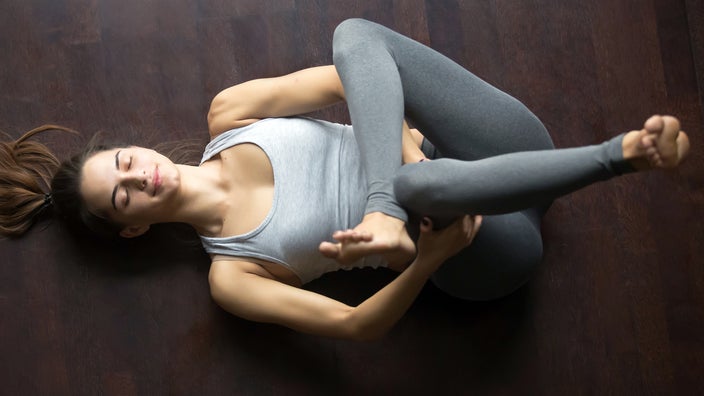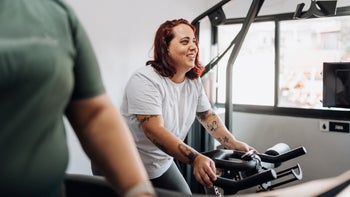
7 SI Joint Stretches and Exercises for Low Back Pain Relief
Key takeaways:
The sacroiliac (SI) joints connect the pelvis and lower spine. SI joint pain may cause low back, hip, or leg discomfort that worsens with sitting, standing, or climbing stairs.
SI joint stretches can loosen tight muscles and improve flexibility in your back and hips. They may also prevent muscle imbalances that irritate your SI joints.
Exercises that strengthen the glutes, hips, and thighs can offer stability to help relieve SI joint pain.

Most people will experience low back pain at some point. But it might surprise you that sacroiliac (SI) joint inflammation or injury causes up to 30% of these cases.
You have an SI joint on each side of your body. They connect the sacrum, or low spine, to the pelvis. Their job is to help support your weight, absorb shock, and stabilize your spine with movement.
Injuries, repetitive stress, or conditions like osteoarthritis may cause SI joint pain. You may notice a sharp or dull ache in your lower back, buttock, hip, or pelvis. It might radiate down the back of your leg and worsen with movements like standing up from sitting. SI joint pain is often only on one side, but you can have discomfort on both sides.
Save over 40% on Qsymia with GoodRx
Discover the once daily Qsymia for weight management. Qsymia is for adults and children 12-17 in combination with a healthy diet and regular exercise.

There are non-invasive treatments to ease your symptoms. SI joint stretches and strengthening exercises can relieve pain and improve function.
What are the best SI joint stretches and exercises to relieve pain?
An exercise regimen with stretches and strengthening moves may help treat SI joint pain.
Here's how it can help:
SI joint stretches: Tense muscles in your back and hips may stress the SI joints, causing muscle imbalances and pain. Stretching is designed to relieve that tension and raise flexibility.
Strengthening exercises: These moves help stabilize the muscles that support your SI joint and lower back. This may be especially important if your SI joint is hypermobile, such as after pregnancy. A small study found that glute-strengthening exercises may ease SI joint pain and improve function. Focus on building strength in your glutes, core, and thighs.
Aerobics: Try light, low-impact aerobics like walking or stationary cycling. It keeps your blood flowing and your body moving. This is important because prolonged sitting can aggravate SI joint pain. Keep your activity pain-free. And avoid high-impact activities like running until your symptoms resolve.
Talk to your healthcare provider if you have questions about exercising with SI joint pain. With their approval, you can try the following SI joint stretches and exercises three times a week. Listen to your body and stop if any movement causes pain.
1. Knee-to-chest stretch
The single knee-to-chest stretch is a gentle move that helps loosen your hip and lower back muscles. Once you can perform this move pain-free, you can pull both knees to your chest at the same time.
Step 1: Lie on your back with your knees bent up and your feet flat.
Step 2: Lift one leg and gently grasp the back of your thigh as you pull your knee toward your chest.
Step 3: Hold for 5 seconds.
Step 4: Place that foot down and switch to the other side.
Step 5: Repeat 5 times on each side.
Read more like this
Explore these related articles, suggested for readers like you.
2. Piriformis stretch
The piriformis muscle is a small glute muscle. SI joint dysfunction can cause piriformis muscle spasms, resulting in pain that travels down your leg. This piriformis stretch can keep the muscle flexible.
Step 1: Lie on your back with your knees bent and feet flat on the floor.
Step 2: Cross your right leg over your left, placing your right ankle on your left knee.
Step 3: Grasp the back of your left thigh and gently pull it toward your chest until you feel a stretch.
Step 4: Hold for 15 seconds.
Step 5: Repeat on the other side.
Step 6: Repeat 3 to 5 times on each side.
3. Side-lying quad stretch
Quadriceps stretches may ease tension and soreness along the front of your thigh. The side-lying quad stretch can be especially for people who sit for prolonged periods. You should only do this stretch if lying on your side doesn't hurt.
Step 1: Lie on one side, with your legs straight and stacked on top of each other. Rest your head on your outstretched arm.
Step 2: Bend your top knee, using your hand to gently pull your heel toward your bottom.
Step 4: Hold for 15 seconds.
Step 5: Repeat 5 times on each side.
4. Trunk rotation stretch
The trunk rotation stretch aims to boost spinal mobility and flexibility. Stop if this movement makes your pain worse.
Step 1: Lie on your back with your knees bent and feet flat on the floor.
Step 2: Place your arms straight out at shoulder level with your palms face up.
Step 3: Keep both shoulders on the floor as you slowly let your knees fall to one side.
Step 4: Hold for a few seconds and then let them fall to the other side. You can place pillows on each side for your legs to fall into if you can't fully relax into the stretch.
Step 5: Repeat 5 times on each side.
5. Hip adductor squeeze
The hip abductor and adductor muscles help you perform functional movements. With the adductor squeeze, you target muscles in your inner thigh. It may reset or improve SI joint alignment and limit pain.
Step 1: Lie on your back with your knees bent and your feet flat.
Step 2: Place a medium-sized ball between your knees.
Step 3: Squeeze your thighs, hold for a count of 5, and relax.
Step 4: Complete 2 sets of 15 reps.
6. Resistance band abduction
This resistance band abduction exercise is a strengthening move that works the glutes and outer thigh muscles.
Step 1: Lie on your back with your knees bent and your feet flat on the floor.
Step 2: Place a resistance band around your legs, just above your knee joint.
Step 3: Squeeze your thigh muscles as you press your legs out against the band and back to center.
Step 4: Complete 2 sets of 15 reps.
7. Bridge
A beginner-friendly move, the glute bridge targets key muscles that support the SI joint. This includes the glutes, hips, and core.
Step 1: Lie on your back with your knees bent and your feet flat on the floor.
Step 2: Place your arms by your side with your palm facing down.
Step 3: Squeeze your glutes and engage your core. Then, lift your hips toward the ceiling.
Step 4: Keep your back straight and hold and squeeze for 5 seconds.
Step 5: Return to the starting position.
Step 6: Complete 2 sets of 15 reps.
What causes SI joint pain?
Unlike other joints in your body, the SI joint has minimal movement. Too much movement (hypermobility) or too little movement (hypomobility) in the joint can lead to pain. Joint misalignment or pelvic asymmetry can also irritate the SI joint.
Common causes of SI joint pain include:
Traumatic injuries like falls or car accidents
Repetitive heavy lifting
Intense exercise
Sports like basketball, football, or soccer
Pregnancy
Leg length discrepancy
Spinal surgery
When should you see a doctor for SI joint pain?
If you are pregnant or injured, you should talk to your healthcare provider before starting an exercise program.
SI joint pain usually resolves with exercise and other first-choice treatments, such as:
Taking a short course of non-steroidal anti-inflammatories (NSAIDs)
Wearing an SI joint belt, especially during pregnancy
Modifying activities that may cause or worsen pain
You should see a doctor if your pain doesn't improve within 2 to 3 weeks. A provider can evaluate you and give hands-on treatment. They may recommend other options like physical therapy or steroid injections. Other warning signs that require a doctor's visit include:
Severe pain at rest
Pain that disturbs your sleep
Bowel or bladder involvement
Numbness, tingling, or weakness in your legs
The bottom line
SI joint pain is often confused with low back or hip problems. But key symptoms — like low back pain just above the buttocks or on one side — can distinguish SI joint pain. A home exercise program, including SI joint stretches and core-strengthening exercises, can help. Talk to a doctor or physical therapist if your pain is related to pregnancy, a condition like arthritis, or a new injury.
Why trust our experts?



References
Added, M. A. N., et al. (2018). Strengthening the gluteus maximus in subjects with sacroiliac dysfunction. International Journal of Sports Physical Therapy.
Al-subahi, M., et al. (2017). The effectiveness of physiotherapy interventions for sacroiliac joint dysfunction: A systematic review. Journal of Physical Therapy Science.
American Academy of Family Physicians. (2022). Sacroiliac joint dysfunction and back pain.
American Council on Exercise. (n.d.). Side lying quadriceps stretch.
Aranke, M., et al. (2022). Minimally invasive and conservative interventions for the treatment of sacroiliac joint pain: A review of recent literature. Orthopedic Reviews.
AskDoctorJo. (2017). Trunk rotation stretch – Ask Doctor Jo. [Video]. YouTube.
Cohen, S. P., et al. (2013). Sacroiliac joint pain: A comprehensive review of epidemiology, diagnosis and treatment. Expert Review of Neurotherapeutics.
Dydyk, A. M., et al. (2020). Sacroiliac joint injury. StatPearls.
Fitzgerald, C. M., et al. (2021). The impact of a sacroiliac joint belt on function and pain using the active straight leg raise in pregnancy-related pelvic girdle pain. PM & R : The Journal of Injury, Function, and Rehabilitation.
Glute Lab. (2019). Banded supine abduction. [Video]. YouTube.
Heneghan, N. R., et al. (2020). Clinical reasoning framework for thoracic spine exercise prescription in sport: a systematic review and narrative synthesis. BMJ Open Sport & Exercise Medicine.
Kumar, N. S. (2015). Efficacy of abductor pull back exercise on pain and functional disability for sacroiliac joint dysfunction. International Journal of Physiotherapy.
MedlinePlus. (n.d.). Back pain.
Peak Physio. (n.d.). Strength: Hip adduction (supine | ball) [isometric].
Raj, M. A., et al. (2022). Sacroiliac joint pain. StatPearls.
Sabino, J., et al. (2008). Pregnancy and low back pain. Current Reviews in Musculoskeletal Medicine.
Sportsinjuryclinic. (2023). Piriformis syndrome exercises.





























